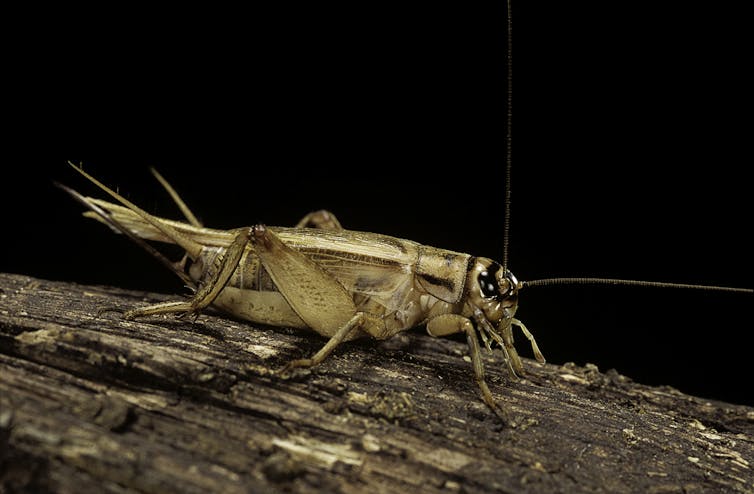
Paul Starosta/Stone via Getty images
![]() Insects communicate in lots of different ways, for many reasons. Some, such as butterflies and beetles, use color, patterns and other visual cues to attract mates or warn potential predators that they don’t taste very good.
Insects communicate in lots of different ways, for many reasons. Some, such as butterflies and beetles, use color, patterns and other visual cues to attract mates or warn potential predators that they don’t taste very good.
Others, like fireflies, use bioluminescence – light that they produce in their bodies – to attract potential mates. Still others send chemical signals to interact with other animals and plants, or to defend against predators.
Insects also use sound to communicate, most often to attract mates. The ways in which they produce sounds can vary a lot, depending on what insect is making the sound.
Ah, there’s the rub
Most insects create sound through a behavior called stridulation, which is basically rubbing two body parts against each other to make a noise, like a bow rubbing across a violin string. In all cases, there is a ridged structure on one body part that is rubbed across the surface of another ridged structure on a different body part, producing sound.
Many arthropods – the group that includes insects, spiders, centipedes, millipedes and lobsters – stridulate for a variety of reasons. They may do it to establish territory or as a warning, but most commonly they use it to attract a mate.
Stridulation has been most thoroughly studied in grasshoppers, crickets and katydids, which all are members of an insect group called orthopterans, meaning “straight wings.” Grasshoppers and katydids rub a hind leg against a wing to make their songs; crickets rub one of their wings quickly over the surface of their other wing. People often describe this as singing, but it’s really more like playing an instrument.
Among crickets, males are the only ones that make noise because females don’t have sound-producing structures on their wings. But the female can hear very well and will come to a male who is signaling to her from some distance away. She also is very good at distinguishing the song of her species from those of other cricket species and zeroing in on the male who is singing to her.
When male crickets sing, they make themselves vulnerable to predators. So they tend to sing from hiding places, such as tall grasses or cracks in rocks. This is why it can be hard to find a chirping cricket that’s inside your house – it’s probably tucked into a vent or the corner of an attic, and it will stop singing when humans approach because it feels the vibrations from their footsteps.
Different cricket species sing slightly different songs. You can learn to recognize them with a little practice, even if you never find the actual crickets. And to know whether a cricket, katydid or grasshopper is singing, look at the time of day. Crickets start to sing beginning at dusk, just as the Sun is going down. Katydids mainly sing late at night when it is totally dark, and grasshoppers sing during the day.
Another insect tune
People in the U.S. Northeast, mid-Atlantic and Midwest will also hear another insect song this spring and summer: cicadas. Two large broods of periodical cicadas, which spend multiyear periods growing underground, will emerge in 2024 to mate. And that will involve a lot of singing.
As with crickets, only male cicadas sing. They make their buzzing and whistling noises using a special structure called a tymbal, which is a membrane on their sides that they vibrate very quickly to produce sound. Think of a drum, but instead of making sound by hitting it on the outside, the surface is vibrated by pulling on it using muscles from the inside.
When many male cicadas sing at once, it can be quite loud. During mass emergences of periodical cicadas, the noise can reach as high as 110-120 decibels – as loud as a jackhammer or a jet engine. If they’re in your neighborhood, you’ll know.
Floyd W. Shockley
Entomologist and Collections Manager,
National Museum of Natural History
 I oversee all aspects of collection management, logistics, purchasing and property management for the Department of Entomology, providing oversight of the National Insect Collection (100,000+ type specimens, 35 million+ specimens) and interacting with staff from the three agencies and 4 units that comprise the Combined Entomology Department (SI, USDA-SEL, USDA-APHIS, and DoD-WRBU).
I oversee all aspects of collection management, logistics, purchasing and property management for the Department of Entomology, providing oversight of the National Insect Collection (100,000+ type specimens, 35 million+ specimens) and interacting with staff from the three agencies and 4 units that comprise the Combined Entomology Department (SI, USDA-SEL, USDA-APHIS, and DoD-WRBU).







